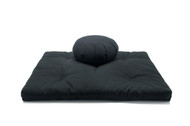A Brief History of the Zafu Meditation Cushion
Posted by Jay Suthers on Jul 13th, 2023
The zafu is a round meditation cushion that is used in Zen Buddhism. It is typically filled with buckwheat hulls, kapok, or other soft materials, and it is designed to help the practitioner maintain a comfortable and dignified sitting posture during meditation.
The history of the zafu is long and complex, but it is generally believed to have originated in China. The word "zafu" is Japanese, and it means "seat of reedmace." This is because the original zafus were filled with the downy fibers of the reedmace plant.
The earliest known records of zafus date back to the Tang dynasty (618-907 CE) in China. These early zafus were used by Chan (Zen) Buddhist monks, who would sit on them for long periods of time during meditation. The zafu helped to support the monks' bodies and to prevent them from becoming fatigued.
In the 12th century, Zen Buddhism spread from China to Japan. The zafu came with it, and it soon became an essential part of Japanese Zen practice. The Japanese zafu was slightly different from the Chinese zafu, in that it was typically filled with kapok instead of reedmace. Kapok is a soft, fluffy fiber that is found in the seed pods of the kapok tree. It is a more resilient material than reedmace, and it is less likely to compress over time.
The zafu continued to evolve in Japan, and by the 16th century, it had become a standard item in Zen monasteries. The zafu was used by both monks and lay practitioners, and it was seen as an essential tool for spiritual development.
In the 20th century, the zafu began to spread to the West. This was due in part to the growing popularity of Zen Buddhism in the West, and in part to the increasing interest in meditation among non-Buddhists. Today, zafus are used by people all over the world, and they are an essential part of many different forms of meditation.
The zafu is a simple but effective tool that can help to improve the quality of meditation practice. It provides support for the body and helps to maintain a comfortable sitting posture. This can make it easier to focus the mind and to achieve a deep state of meditation.
In addition to its practical benefits, the zafu can also be seen as a symbol of spiritual practice. It is a reminder of the importance of sitting meditation, and it can help to cultivate a sense of calm and focus.
The zafu is a versatile tool that can be used by people of all levels of experience. It is a simple and effective way to improve the quality of meditation practice, and it can be a valuable companion on the path to spiritual development.
Here are some additional facts about the zafu:
- The traditional size of a zafu is about 12 inches in diameter and 4 inches thick.
- Zafus are typically made from a variety of materials, including cotton, wool, and silk.
- The filling of a zafu can vary, but it is most commonly made from buckwheat hulls, kapok, or rice husks.
- Zafus can be purchased from a variety of online and brick-and-mortar retailers.
- There are many different styles of zafus available, so you can choose one that best suits your needs and preferences.
The zafu is a valuable tool for meditation practice. It can help to improve your sitting posture, reduce fatigue, and promote a sense of calm and focus. If you are interested in meditation, I encourage you to try using a zafu. You may be surprised at how much it can help you to improve your practice.
Thank you for reading,
Jay
If you would like to comment on this blog or have any questions, please feel free to Contact Sage Meditation Customer Service.

